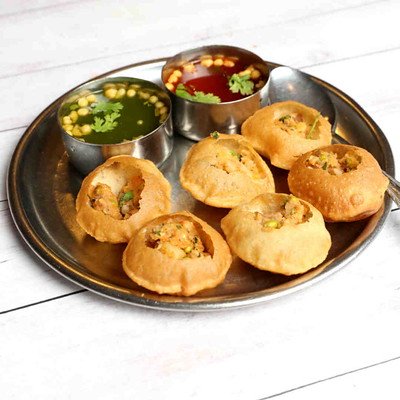Read in : தமிழ்
A hugely popular snack, pani puri is sold in pushcarts in the streets. Adults and children love it. The combination of flavours from sweet to tangy to spicy makes it the quintessential Indian chaat full of carefree fun and wholesome flavour. Made popular by migrant workers, pani puri carts today are as ubiquitous in Tamil Nadu cities as in the north. But questions over hygiene remain since the snack needs much work by hands and to make, serve and eat.
Pani Puri, as it is typically called in Maharashtra, has white peas curry filled in the imli chutney that goes inside. In West Bengal and other eastern states, it is puchkas. Puchkas contains boiled gram, mashed potatoes, tangy chutney and spicy water as the filling. Also the puri is darker and bigger in size.
Golgappa, the third variant, has a mix of potatoes, chickpeas, tangy chutney, sweet water, mint and spices as the filling. And the fourth variant, found in Odisha, is called gupchup because it eliminates the potatoes and is much lighter to eat. Outside of India, panipuri is now known as water pancakes or water balls.
The most common pani is tikhahari puri or green colored mint and coriander infused water, but it can also be extended to other types. The 6 types of pani (asafoetida, jeera, aamchur, garlic, meetha, theeka) are easily prepared with the basic ingredients, yet have an amazing flavor with cooling effect.
Pani puris are best served at room temperatures, but you may serve them chilled too.
Pani refers to water (here the spicy version of water). Puri is the deep fried puffed bread that’s crispy and hollow. The hollow puris are stuffed with masala (made of boiled potato, black chickpeas or sprouted moong), with a sprinkle of chopped onion and filled with tikha or khatta meetha pani. The trick lies in making it just before eating so that the puri doesn’t become soft and soggy.
If the water used for making the pani or mint water is not pure, then that can harm, too. The pani puri dough is kneaded using bare feet. At home though, the dough is kneaded by hand. The former is clearly unhygienic.
Although pani puris are widely preferred and consumed across India , the quality can be uneven. Also, hygiene and food safety are concerns.
Unhygienic practices
Among snacks, pani puri has probably the highest risk of infection. It is recommended to avoid eating this item in street pushcarts but to have it served at a hygienic outlet prepared in a healthy way.
One will have to check the cleanliness of the hand of the seller who breaks, stuffs masala in and dips the puri in the pani bowl. Its proven that hookworms and pinworms are spread through hands. So, eating pani puri implies a likelihood of worms being produced in the stomach.
The oil in which the puris are fried needs to be checked, to ensure they are not re-used. Re-used oil is harmful enough to lead to cancer.
If the water used for making the pani or mint water is not pure, then that can harm, too. The pani puri dough is kneaded using bare feet. At home though, the dough is kneaded by hand. The former is clearly unhygienic.
Many shops are located very near the sewer. The ambience is quite unhealthy as well.
We come across carts selling pani puris with gloved hands, but we are unaware of the quality of water the vessel holds, and handling of other ingredients. We see a lot of golgappawalas wrap red coloured cloth as it is more attention grabbing. These golgappawalas use green pani, sap green to be specific. Mixture of red and green results in black color, which makes the stains look black.

(Photo Credit : Pani Puri Recipe muthuhealthy recipe- Flickr)
In contrast, there are pani puri stalls where the vendors are keen on hygiene. They care about the oil, dough, water and the ingredients they use as fillings and storage. The server prepares the puffed puris and then hands them over to the customer, who can then choose from a variety of flavoured water options from a machine. The machine uses sensors to dispense the flavoured water and doesn’t need human intervention. They are offered with a variety of flavours like ginger lemon, chatpata, kaccha mango, khattameetha, jaljeera, and pudina, apart from the newer trends that serve chocolate puri, pizza puri, fire puri, pan shots.
In modern times, ready-to-fry small puris (panipuri pellets or fryums) are offered with attractive packaging and adherence to food quality. They are produced hygienically and packed in air-tight packets for keeping the puris fresh without losing their taste, crunchiness. These puris also absorb less oil, making them healthier to eat. The pellets are ready to fry or microwave.
Food safety
Some of the common food safety issues are complaints of vomiting after eating pani puris which have been reported to the food safety department . During raids by food safety officials, the officers did not find anything seriously wrong, but found stale puris being served. There were alarmingly high counts of microbes, particularly staph aureus, which in large quantities causes food poisoning.
Most of pani puri sellers buy from one supplier and the puris were found to be high in gluten, which may cause an upset stomach to intolerant eaters. The food safety department operates only if an incident is brought to their notice, as the number of sellers far outnumber the available food safety officers .
FSSAI (Food safety Authority, India) has initiated the “Clean street food hub process” to upgrade existing food streets across the country and provide safe and hygienic local eating experience.
Read in : தமிழ்











